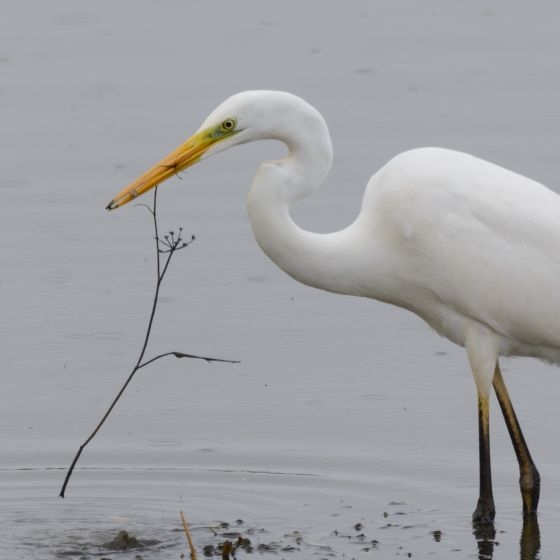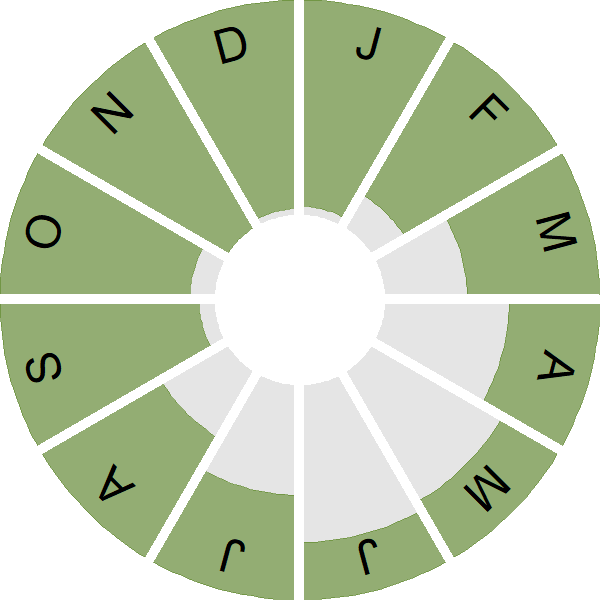Great White Egret

Introduction
A bird of wetland and marsh, the Great White Egret is one of a small group of Continental heron species that have expanded their breeding ranges northwards and joined our avifauna.
Formerly a very rare bird in Britain & Ireland, the Great White Egret can now be seen throughout the year, often in association with other herons, when its long, sinuous neck, long legs and large size can be fully appreciated as it hunts its aquatic food.
Wetland Bird Survey data show the meteoric rise in Great White Egret numbers since it began colonising in around 2010. It is also monitored by the BTO Heronries Census and BirdTrack.

Key Stats
Identification
ID Videos
This section features BTO training videos headlining this species, or featuring it as a potential confusion species.
Little Egret and Great White Egret
Songs and Calls
Flight call:
Status and Trends
Conservation Status
Population Change
The recent trend for Great White Egret suggests it has now successfully colonised the UK, with the numbers of breeding pairs and sites both increasing rapidly since the species first bred in 2012 (Anderson et al. 2013). A total of 16–24 pairs bred in 2019 (Eaton et al. 2021) and breeding numbers are expected to increase further in the coming years.
Distribution
Like the other two egret species, Great White Egrets are now recorded widely in Britain throughout the year. During the Atlas breeding period 134 10-km squares in Britain and 12 in Ireland were recorded as occupied by non-breeding birds. Since then, breeding has been confirmed at a number of locations.
Occupied 10-km squares in UK
2007/08–10/11
or view it on Bird Atlas Mapstore.
2008–11
or view it on Bird Atlas Mapstore.
European Distribution Map
Distribution Change
Change in occupied 10-km squares in the UK
from 1981–84 to 2007–11
or view it on Bird Atlas Mapstore.
Seasonality
Great White Egrets are more likely to be seen in winter than at other times of year, but can now be seen year-round at many southern locations.
Weekly pattern of occurrence
The graph shows when the species is present in the UK, with taller bars indicating a higher likelihood of encountering the species in appropriate regions and habitats.

Movement
Britain & Ireland movement
Foreign locations of birds ringed or recovered in Britain & Ireland
Dots show the foreign destinations of birds ringed in Britain & Ireland, and the origins of birds ringed overseas that were subsequently recaptured, resighted or found dead in Britain & Ireland. Dot colours indicate the time of year that the species was present at the location.
- Winter (Nov-Feb)
- Spring (Mar-Apr)
- Summer (May-Jul)
- Autumn (Aug-Oct)

European movements
EuroBirdPortal uses birdwatcher's records, such as those logged in BirdTrack to map the flows of birds as they arrive and depart Europe. See maps for this species here.
The Eurasian-African Migration Atlas shows movements of individual birds ringed or recovered in Europe. See maps for this species here.
Biology
Survival and Longevity
Survival is shown as the proportion of birds surviving from one year to the next and is derived from bird ringing data. It can also be used to estimate how long birds typically live.
View number ringed each year in the Online Ringing Report.
Classification, names and codes
Classification and Codes
- Order: Pelecaniformes
- Family: Ardeidae
- Scientific name: Ardea alba
- Authority: Linnaeus, 1758
- BTO 2-letter code: HW
- BTO 5-letter code: GRWEG
- Euring code number: 1210
Alternate species names
- Catalan: agró blanc
- Czech: volavka bílá
- Danish: Sølvhejre
- Dutch: Grote Zilverreiger
- Estonian: hõbehaigur
- Finnish: jalohaikara
- French: Grande Aigrette
- Gaelic: Corra-gheal-mhòr
- German: Silberreiher
- Hungarian: nagy kócsag
- Icelandic: Mjallhegri
- Irish: Éigrit Mhór
- Italian: Airone bianco maggiore
- Latvian: baltais garnis
- Lithuanian: didysis baltasis garnys
- Norwegian: Egretthegre
- Polish: czapla biala
- Portuguese: garça-branca
- Slovak: beluša velká
- Slovenian: velika bela caplja
- Spanish: Garceta grande
- Swedish: ägretthäger
- Welsh: Crëyr Mawr Gwyn
Research
Causes of Change and Solutions
Causes of change
Like other egret species, the expansion of Great White Egret into the UK has followed increases on the continent and an expansion north and west across Europe. The key drivers behind this expansion are unclear, but contributing factors may include increases and improvements to habitat, reduced persecution and improved legal protection and climate change (?awicki 2014).
More Evidence
More evidence from Conservation Evidence.com
Partners
Citing BirdFacts
If you wish to cite particular content in this page (e.g. a specific value) it is best to use the original sources as linked in the page. For a more general citation of the whole page please use: BTO (20XX) BirdFacts Species: profiles of birds occurring in the United Kingdom. BTO, Thetford (www.bto.org/birdfacts, accessed on xx/xx/xxxx).

